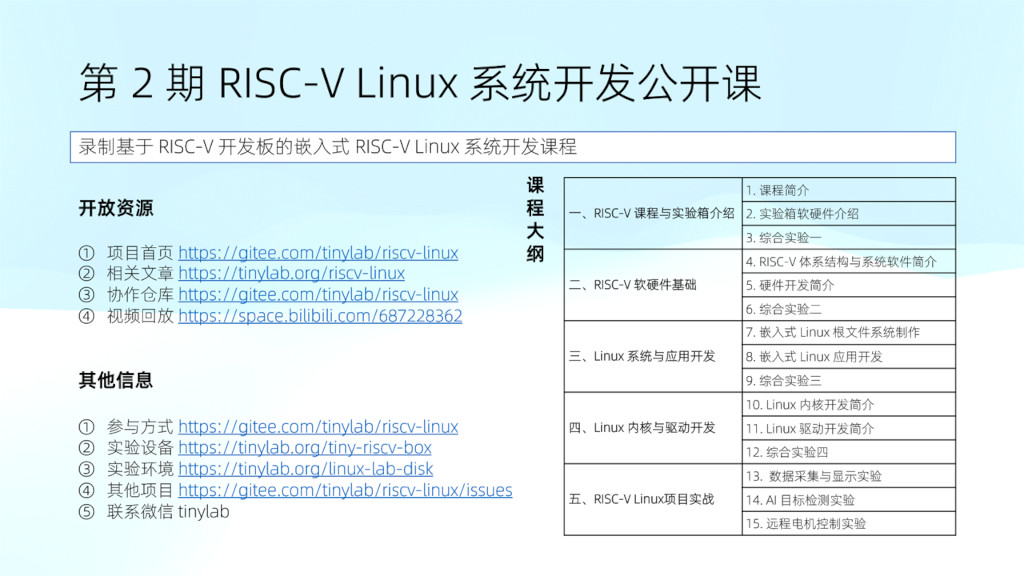[置顶] Linux Lab v1.2 升级部分内核到 v6.3.6,升级部分 QEMU 版本到 v8.0.2,新增 nolibc 和 NOMMU 开发支持,另有新增 4 款虚拟开发板:ppc/ppce500, arm/virt, loongarch/virt 和 s390x/s390-ccw-virtio。Linux Lab 发布 v1.2 正式版,新增 4 款虚拟开发板,支持 LoongArch, Linux v6.3.6 和 QEMU v8.0.2
Linux 文件系统:procfs, sysfs, debugfs 用法简介
by falcon of TinyLab.org 2014/08/25
前言
内核中有三个常用的伪文件系统:procfs,debugfs和sysfs。
- procfs — The proc filesystem is a pseudo-filesystem which provides an interface to kernel data structures.
- sysfs — The filesystem for exporting kernel objects.
- debugfs — Debugfs exists as a simple way for kernel developers to make information available to user space.
它们都用于Linux内核和用户空间的数据交换,但是适用的场景有所差异:
- procfs 历史最早,最初就是用来跟内核交互的唯一方式,用来获取处理器、内存、设备驱动、进程等各种信息。
- sysfs 跟 kobject 框架紧密联系,而 kobject 是为设备驱动模型而存在的,所以 sysfs 是为设备驱动服务的。
- debugfs 从名字来看就是为debug而生,所以更加灵活。
它们仨的挂载方式类似,做个实验:
$ sudo mkdir /tmp/{proc,sys,debug}
$ sudo mount -t proc nondev /tmp/proc/
$ sudo mount -t sys nondev /tmp/sys/
$ sudo mount -t debugfs nondev /tmp/debug/
不过,默认情况下,它们分别挂载在/proc,/sys/,/sys/kernel/debug/。
下面简单介绍这三个文件系统的用法。在介绍之前,请记下他们的官方文档:
- procfs — Documentation/filesystems/proc.txt
- sysfs — Documentation/filesystems/sysfs.txt
- debugfs — Documentation/filesystems/debugfs.txt
debugfs
API说明
struct dentry *debugfs_create_dir(const char *name, struct dentry *parent) struct dentry *debugfs_create_file(const char *name, umode_t mode, struct dentry *parent, void *data, const struct file_operations *fops)参考实例
drivers/base/power/wakeup.c:
/** * wakeup_sources_stats_show - Print wakeup sources statistics information. * @m: seq_file to print the statistics into. */ static int wakeup_sources_stats_show(struct seq_file *m, void *unused) { struct wakeup_source *ws; seq_puts(m, "name\t\tactive_count\tevent_count\twakeup_count\t" "expire_count\tactive_since\ttotal_time\tmax_time\t" "last_change\tprevent_suspend_time\n"); rcu_read_lock(); list_for_each_entry_rcu(ws, &wakeup_sources, entry) print_wakeup_source_stats(m, ws); rcu_read_unlock(); return 0; } static int wakeup_sources_stats_open(struct inode *inode, struct file *file) { return single_open(file, wakeup_sources_stats_show, NULL); } static const struct file_operations wakeup_sources_stats_fops = { .owner = THIS_MODULE, .open = wakeup_sources_stats_open, .read = seq_read, .llseek = seq_lseek, .release = single_release, }; static int __init wakeup_sources_debugfs_init(void) { wakeup_sources_stats_dentry = debugfs_create_file("wakeup_sources", S_IRUGO, NULL, NULL, &wakeup_sources_stats_fops); return 0; }创建完的接口
/sys/kernel/debug/wakup_sources给接口添加多级目录
上述接口直接创建在
debugfs根目录(/sys/kernel/debug)下,所以debugfs_create_file的parent参数被设置成了NULL,如果要加一级目录,则可以先用debugfs_create_dir创建一级目录,例如,要创建:/sys/kernel/debug/power/wakeup_sources的话,则需要:struct dentry *power; int err = -ENOMEM; power = debugfs_create_dir("power", NULL); if (!power) return err; wakeup_sources_stats_dentry = debugfs_create_file("wakeup_sources", S_IRUGO, power, NULL, &wakeup_sources_stats_fops);
procfs
API说明
static inline struct proc_dir_entry *proc_mkdir(const char *name, struct proc_dir_entry *parent) static inline struct proc_dir_entry *proc_create(const char *name, umode_t mode, struct proc_dir_entry *parent, const struct file_operations *proc_fops)参考实例
在上面例子的基础上,可以添加如下语句:
static int __init wakeup_sources_debugfs_init(void) { proc_create("wakelocks", S_IFREG | S_IRUGO, NULL, &wakeup_sources_stats_fops); return 0; }创建后的接口
/proc/wakelocks给接口添加多级目录
这样创建的接口用起来跟
/sys/kernel/debug/wakeup_sources没有任何差异,类似地,如果要加一级目录,例如/proc/power/wakelocks,则可以:struct proc_dir_entry *power; int err = -ENOMEM; power = proc_mkdir("power", NULL); if (!power) return err; proc_create("wakelocks", S_IFREG | S_IRUGO, power, &wakeup_sources_stats_fops);proc_mkdir用法跟debugfs_create_dir几无差异。
sysfs
API说明
struct kobject *kobject_create_and_add(const char *name, struct kobject *parent) int sysfs_create_file(struct kobject * kobj, const struct attribute * attr) static inline int sysfs_create_link(struct kobject *kobj, struct kobject *target, const char *name) int device_create_file(struct device *dev, const struct device_attribute *attr)参考实例
在
/sys/power下创建一个 wakelocks 节点,用于读/写一个字符串。static char test_str[11]; static ssize_t show_wakelocks(struct kobject *kobj, struct attribute *attr, char *buf) { int ret; ret = snprintf(buf, 10, "%s\n", test_str); return ret; } static ssize_t store_wakelocks(struct kobject *kobj, struct attribute *attr, const char *buf, size_t count) { int tmp; ret = sscanf(buf, "%10s", test_str); if (ret != 1) return -EINVAL; return count; } define_one_global_rw(wakelocks); static int __init wakelocks_init(void) { int ret; ret = sysfs_create_file(power_kobj, &wakelocks.attr); }创建后的节点
/sys/power/test_node给接口添加多级目录
咱们上面其实已经把 test_node 创建在
/sys/power目录下,而非根目录/sys下,而参数 power_kobj 为内核已经在kernel/power/main.c创建的kobject对象。struct kobject *power_kobj; power_kobj = kobject_create_and_add("power", NULL); if (!power_kobj) return -ENOMEM;在
sysfs中,有另外一个常见用法,那就是在一个 kobject 对应的目录下创建一个符号(属性文件)指向另外一个 kobject 对应的目录,通常这个是为了方便记忆和访问。这个API是sysfs_create_link。这种创建符号链接方法其实有一个很特殊的实例,那就是在驱动模型里头,有一个
class的概念,它把挂在不同总线上,但是实现类似功能的设备进行归类,比如说input类,backlight类等。如果设备属于一个现存的类,比如
backlight,那么可以用backlight_device_register创建,如果是I2C设备,会先在I2C下创建sysfs访问节点,并创建一个符号链接到backlight类所属的目录下。当然,如果没有找到设备能挂的直观的类,也可以用
class_create创建类,设备类通常会有一组默认的设备操作接口,例如backlight类有bl_device_attributes,如果要创建更多的设备特定的节点,可以用device_create_file或者device_add_groups创建节点或者节点群。
小结
通过比较发现,上述三个文件系统的 API 用法类似,而其中 debugfs 和 procfs 几乎有相同的参数,用的主要结构体是 struct file_operations,蛮多操作可以用 seq_* 家族的函数来实现。而 sysfs 则用到比较简单一些的 struct global_attr 结构体。对于提供给用户空间的节点,都可以轻松实现读写操作。
在创建目录方面,debugfs 和 procfs 类似,且比较简单。而 sysfs 要创建一级目录,需要先创建一个 kobject 对象。
为了简化设备模型依据总线创建的访问节点路径,sysfs 提供了API用于创建更简易的符号链接,可以创建到自己指定的目录下,也可以用设备类(Class)提供的API创建到设备类所属的目录下。
对于 sysfs,由于 kobject 与 device 的一对一依存关系,也可以直接用 device_create_file 来创建节点。
猜你喜欢:
- 我要投稿:发表原创技术文章,收获福利、挚友与行业影响力
- 知识星球:独家 Linux 实战经验与技巧,订阅「Linux知识星球」
- 视频频道:泰晓学院,B 站,发布各类 Linux 视频课
- 开源小店:欢迎光临泰晓科技自营店,购物支持泰晓原创
- 技术交流:Linux 用户技术交流微信群,联系微信号:tinylab
| 支付宝打赏 ¥9.68元 | 微信打赏 ¥9.68元 | |
 |  请作者喝杯咖啡吧 |  |


